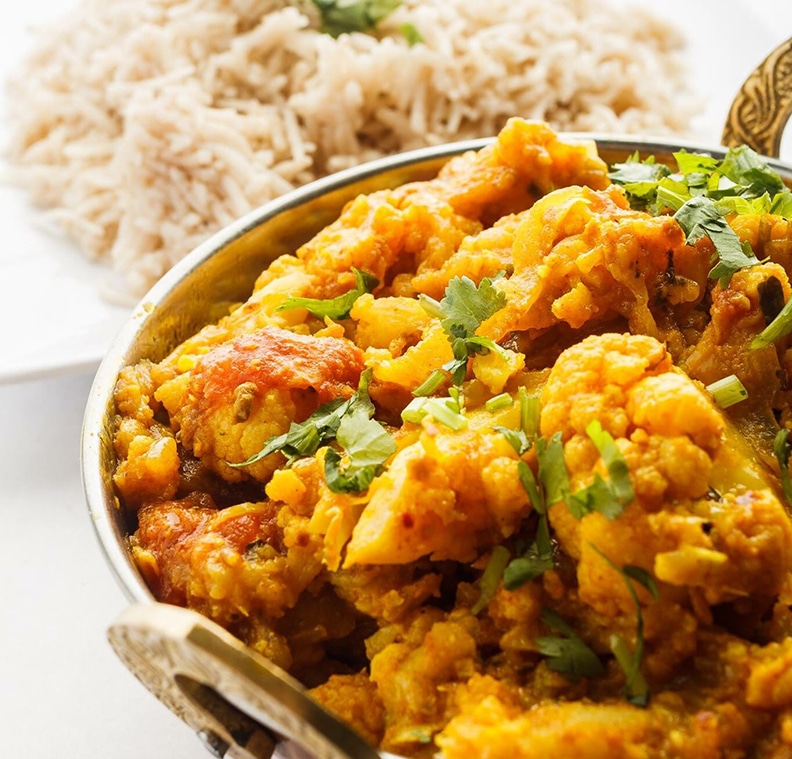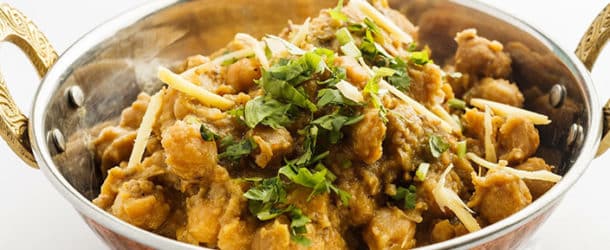By Danny Garrett
Of the countless food cultures that exist in the world, Indian is arguably the most vegetarian. The ubiquity of vegetables in Indian cuisine isn’t by accident.
The best place to begin in understanding why plants are so positively pervasive in India is religion. Hinduism is India’s dominant religion, with nearly 80 percent of Indians counting themselves as Hindu.
In this faith, the cow is sacred. As a new visitor to the Indian subcontinent, it’s best not to be alarmed if you witness a cow lethargically meandering through an unpaved dirt road in Kolkata unrestrained and unharmed. Hindus view the loveable bovine as a source of life and sustenance, and thus believe cows must not be slaughtered.
In fact, as early as the ancient period, Rig Veda scriptures venerated cows as a Devi (goddess) and an animal most commonly associated with Aditi (the mother of the gods).

Yet, Hinduism is quite mild compared to one of its later religious outgrowths, Jainism, a faith in which you must be a vegetarian.
In such a bath of religious precedent with an ethical and spiritual perspective about meat, you get a country that’s between 30 and 40 percent vegetarian, which outnumbers most countries by double digits. You also get a food culture that knows how to cook vegetables to their full potential.
Luckily, in Lake Charles, we have Raja’s Curry Kitchen and Grill, located at 3821 Ryan St. In Hindi, Raja means “king.” Two friends have run Raja’s since its opening in November, 2015. Raja is the name of one of the owners, who also happens to be the head chef. It’s best to see him and his co-owner as an amalgamation: two men as one. They’re both humble, so full individual names aren’t crucial. In fact, for the restaurant, their birth names dissolve into one name; that is, Raja.
Raja is from Pakistan. It’s where his culinary adventure started.
In terms of cuisine, what does Pakistan have to do with India? Quite a bit, actually. Before 1947, Pakistan and India were one country, so they share a great deal culturally. They both love their cricket. The “salwar kameez” is a popular form of dress in both regions. And Urdu and Punjabi are common spoken languages in these two Asian countries.
Thus, for Raja, when it comes to Indian and Pakistani cuisine, otherwise known as Indo-Pak, it’s a distinction with very little difference.
Raja’s has it all in terms of excellent Indo-Pak vegetarian cuisine: Chana Masala, Aloo Gobi, Dal Makhani, okra curry, and naan bread. When you’re unsure of what to try on your first, or, in my case, fourth visit, it’s recommended to try their buffet, which runs from 11 am-4 pm Monday-Saturday and noon-4 pm on Sundays. There and then, you can try it all.

Raja’s Aloo Gobi is similar in its colored vibrancy, zestful flavors and spiced aromatic notes. “Aloo” means potato, and “Gobi” stands for cauliflower. Those are the two main vegetable ingredients in the meal. With only those ingredients, the meal would be trite and dull. But this is Indian cuisine, which exists nowhere near a spectrum of dullness. The turmeric in Aloo Gobi graces the meal with its brilliant yellow coloring, and the coriander and cumin give the meal its complex flavor pairing. The stir-fried cauliflower bathed in those spices turns a normally bland-tasting vegetable into a slightly crunchy and delicious meal that even a carnivore would enjoy.
Raja is proud of the culinary prestige that Indian cuisine has garnered over the centuries. The food has been held in high esteem by countless cultures. But Raja also loves the science behind the enjoyment. He’s quite fond of quoting Sabrina Toppa’s Time Magazine article, “This Is Why Indian Food Is So Delicious.” Read the editorial’s full version at The Washington Post, and you’ll see why he loves it. The article’s a tour-de-force in explaining what makes Indian food delicious — all the way down to the molecular level. Western cuisines usually pair ingredients based on their similar flavors, but, says Toppa, “an average Indian dish includes at least seven ingredients, most of which do not contain overlapping flavors. Cayenne, green bell pepper, coriander and garam masala are usually paired with ingredients that have no chemical overlap. But each ingredient brings a unique component when incorporated into the final meal. This creates knockout dishes for a cuisine that uses approximately 200 of the estimated 381 ingredients known in the world.”
In other words, the less chemical overlap in food, the better. That’s Indian cuisine backed by science.
I know meat is among those 200 ingredients. But a tremendous number of vegetables, herbs, breads and spices are included. Ask a vegetarian what he or she eats, and I hope you’re pointed towards Indian cuisine. Okra, lentils, chickpeas, and cauliflower, all of which can be bathed in a simmering pot of curry, cayenne, garam masala, coriander and cloves. You can’t miss the diversity.
Raja’s has only been open since 2015. It fills another missing niche in the Lake area. I’m glad it opened. As I enjoyed the warm, light and fluffy naan — another freshly made meal at Raja’s — I relaxed with appreciation. Bollywood music drifted from the speakers. Sri Lanka competed against South Africa in a cricket game on television. Indian art — clay pots adorned with golden flowers and clear rhombuses and miniature, meticulously designed camel figurines – surrounded the house tables.
The atmosphere celebrated Indian diversity, flair and prestige – just like the cuisine.
Raja’s Curry Kitchen And Grill
3821 Ryan St, Lake Charles
337-476-2777















Comments are closed.